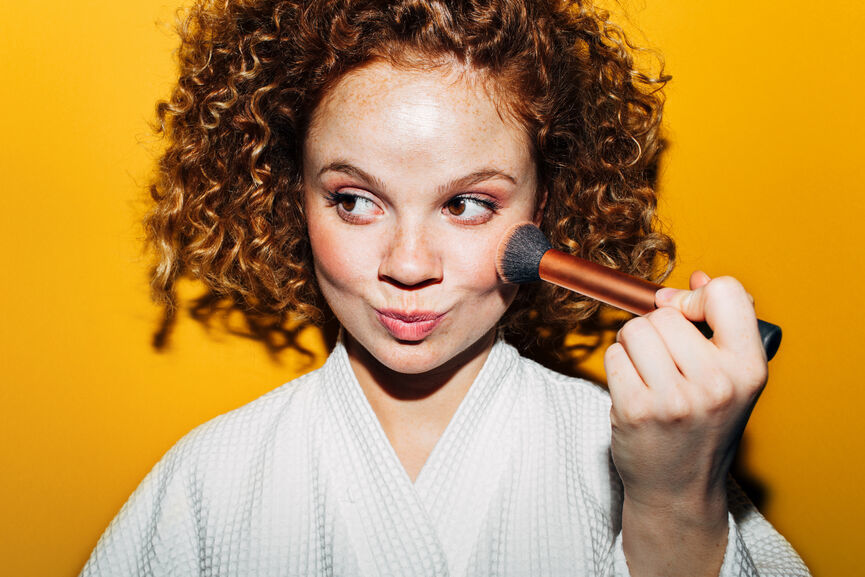Keep Foundation From Sliding Off Your Face by Noon With These Pro-Approved Hacks
Some formulations are longer lasting than others—try these oil-free pro picks, for example—but experts tell me there are also tricks of the trade to keep foundation from sliding off the skin. The key is to start thinking about your foundation well before you apply it; below, four steps to everlasting perfection of the skin (or a close approximation of such, at least).

1. Consider your moisturizer
According to Merrady Wickes, a makeup artist and beauty director for The Detox Market, long-lasting foundation starts with your choice of moisturizer. "Beyoncé's makeup artist, Sir John, recently revealed he doesn't moisturize her before performances because the moisture in her primer and foundation are enough, and he doesn't want anything sliding around." While I wouldn't recommend skipping hydration on the daily, you should consider the textures of your layers, your skin type, and the current season. For example, if your foundation is rich and creamy, and your skin is combination, you may want to opt for a lightweight serum or lotion. "I love the newly launched Josh Rosebrook Hydration Boost Concentrate ($42)—it's oil-free but super plumping. Conversely, if you lean dry and your skin tends to 'eat' your makeup, you may not be using enough moisture. If your foundation is oil-free or mattifying, prep with something very nourishing, like the Osea Advanced Protection Cream, ($108)" she says.
2. Personalize your primer
You'll then want to select a primer that's specific to your skin type, says makeup artist Neil Scibelli. "If you're oily, go with a primer that is mattifying so that your foundation lays smoother throughout. If your skin is more on the dry side, go for a primer that is super hydrating so that your foundation glides on smoother and also doesn't look flakey or cakey. For oily skin, try CC by Clean & Clear's No Glow Anti-Shine Stick ($16) as a mattifying primer or even as a mid-day oil absorbing touchup stick. It really blurs the look of pores, shine. It's great on its own or under—or even over—makeup. For dry skin, the classic Embryollise ($16) has always been a great moisturizer and primer for myself and tons of other makeup artists. I also love Charlotte Tilbury Wonderglow ($56), which helps lock in moisture and also adds that luminous glow that helps your skin look more hydrated," he says.

{{post.sponsorText}}
3. Don't skip powder
Wickes tells me pro makeup artists "wouldn't be caught dead without a variety of setting powders in their kit," but acknowledges that most of us ordinary folk are terrified of powdering our makeup—probably because we've been doing it wrong. "Powder is the single most effective way to get your concealer and foundation to last, but put down the giant powder puff and massive kabuki brush. Strategically placed powder with a small brush and a light hand is key. If your skin is dry, mature, or you like a dewy finish, I like the Hynt Beauty Finale Finishing Powder ($40). It's more of a gentle set because it's made with arrowroot powder. If your skin leans oily, you like a matte finish, or you really need your makeup bulletproof, I really like the silica-based RMS "Un" Powder ($34). Use a very fluffy crease brush or a small contouring brush to apply powder only on your T-zone and anywhere you need to set concealer. Bonus: powdering lightly under your eyes also keeps your eyeliner and mascara from smudging," she says.
4. Add some H20
While you may be tempted to stop at step #3, Scibelli says your work is not yet done. "A pro tip for midday or to touchup your foundation is to mist your skin with a toning mist or any simple mist, and then roll a beauty blender over your foundation," he says. "This will bind the existing foundation back into your skin, and smooth out any product imperfections."
Sound like a lot of work? Maybe try getting semi-permanent organic foundation microneedled into your skin instead. Or you could just join the acne/skin acceptance movement which, IMO, is well overdue on the scene.
Loading More Posts...